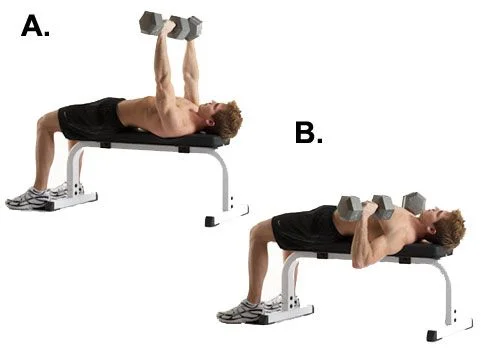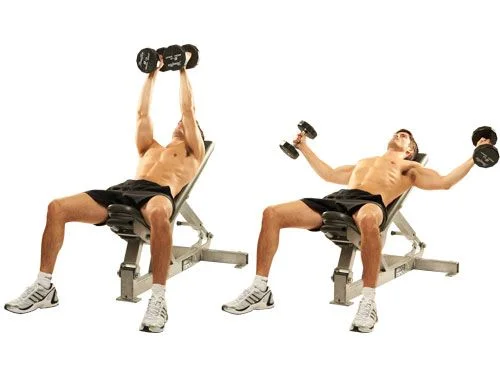Chest workouts with dumbbells are a great way to build strength, size, and definition in your chest muscles. Dumbbells are versatile and affordable pieces of fitness equipment that can be used to perform a wide variety of chest exercises.
You may have heard the gym rats in your life talk about “blasting their pecs” on a bench press day. But strengthening your chest is incredibly important not only for aesthetic reasons but for functional ones as well.
muscles make up your chest
The most common chest muscle that comes to mind is the pectoralis major, which is responsible for elevating your arm in front of you, dropping your arm to the side, and rotating your arm inward. The pectoralis minor, which is positioned beneath the pectoralis major and is responsible for shoulder blade stability, is also present.
Lastly, there’s the serratus anterior, located deep under the pectorals on the lateral surfaces of the rib cage, responsible for pulling your shoulder blades forward, which in turn allows you to reach in front of you.
10 chest workouts with dumbbells
1. DUMBBELL CHEST PRESS

The dumbbell chest press is a simple but extremely popular exercise. While it works all of the major chest muscles, it also works your shoulders and, when done correctly, your back, making it an excellent upper-body strengthening exercise.
To perform the chest press, grab two moderately heavy dumbbells and place them in front of you. Take a seat on a weight bench, pick up the dumbbells from the floor, and slowly lower yourself onto the bench until you’re lying flat. Bring your arms to a right angle, with your elbow lined up slightly below your shoulder, your wrists neutral, and your knuckles facing the wall behind you.
Squeezing your chest, straighten your arms, and press both weights into the air. To avoid impinging the shoulder joint, position the weights slightly in front of the shoulder, directly above your sternum (think “nipple line”). By retracting (or “squeezing together”) your shoulder blades, slowly lower the weights back to the beginning position.
If you don’t have access to a bench, perform the exercise lying on a mat instead.
2. CRUSH GRIP DUMBBELL PRESS

Similar to a Svend press, the crush grip dumbbell press adds an extra challenge to a pressing motion by maintaining a constant contraction of the chest muscles throughout the entirety of the exercise.
Grab two moderately heavy dumbbells and set them in front of you to do the crush grip dumbbell press. Take a seat on a weight bench and grab a pair of dumbbells. Slowly lower yourself to a lying position. Hold the dumbbells vertically, with the ends of each bell touching and aligned with your sternum. Squeeze your chest muscles as you “crush” the dumbbells together, then press both dumbbells up to the ceiling. Lower the weights slowly back to the starting position while maintaining pressure on the dumbbells.
Repeat for 10-12 repetitions until you reach muscle fatigue.
If you don’t have access to a weight bench, perform the crush grip dumbbell press on a mat.
If you only have one dumbbell or if your dumbbells are circular rather than hexagonal, perform the crushing press with one dumbbell: hold the weight horizontally and press against each end with your hands.
3. STANDING CROSS-BODY DUMBBELL RAISE
The standing cross-body dumbbell raise is a great way to target the lower part of your chest.
Choose a light to moderately heavy dumbbell for the standing cross-body dumbbell raise. Stand with your feet approximately hip-width apart and your core engaged. Squeeze the right pectoral while holding the dumbbell in your right hand, slightly bending the elbow and gently bringing the weight up with an underhand grip toward the left shoulder. Lower yourself back to your starting position.
Perform for 10-12 repetitions, and then repeat with the left arm.
4. DUMBBELL CHEST FLY

The dumbbell chest fly is another very popular choice for strengthening all the chest muscles.
Place two light to moderately heavy dumbbells in front of you to do the dumbbell chest fly. Take a seat on a weight bench, pick up the dumbbells from the floor, and slowly lower yourself until you’re resting flat. Raise both dumbbells into the air, palms facing each other and directly over the sternum. Slowly lower the weights to the side with a tiny bend in your elbow, maintaining your arm posture locked, expanding your chest, and retracting your shoulder blades.
Engage your chest muscles and return the weights to the beginning position once you’ve reached the end of your range. Perform a set of 10-12 repetitions, working up to muscle fatigue on the last repetition.
To add variety to the chest fly, try alternating between your left and right arm, or perform all repetitions on one arm before moving to the next.
If you don’t have access to a weight bench, perform the chest fly while lying on a mat.
5. DUMBBELL SVEND PRESS
If you spend enough time at the gym, you’ll eventually come across someone performing a Svend press. This exercise is typically performed with plates to warm up for bench pressing, but it may also be difficult on its own with a dumbbell or two.
To perform the Svend press, select two light to moderately heavy dumbbells. Hold them by the handles, vertically oriented, and squeeze them together. Stand with your feet about hip-width apart, and engage your core. Bring the dumbbells in towards your sternum, then extend your arms and press the dumbbells away from you in a straight line, keeping them pressed together.
Repeat this motion for 10-12 repetitions, reaching muscle fatigue on your final rep.
To add variety to the Svend press, press the dumbbells away from you diagonally, in both upward and downward motions.
Perform the Svend press with a single dumbbell if you only have one, or if your dumbbells are circular rather than hexagonal: hold the dumbbell horizontally and push into either end with your hands.
6. DUMBBELL PULLOVER
While the pullover is sometimes used to target the latissimus dorsi (a large muscle in the back), it can also be used to strengthen the chest.
Pick up one reasonably heavy dumbbell to do the dumbbell pullover. Lower yourself slowly onto a weight bench, holding a dumbbell vertically by one end directly over your sternum. Ground your feet into the floor, depress your shoulder blades, and lower the dumbbell behind your head slowly.
Once you’ve reached the end of your range, engage your chest muscles and bring the dumbbell back to the starting position. Repeat for 10-12 repetitions, achieving muscle fatigue by the end of the set.
If you don’t have a weight bench, you can do the dumbbell pullover on the floor, but your range of motion will be limited.
7. INCLINE DUMBBELL CHEST PRESS
The incline dumbbell chest press is another variation of the chest press, meant to target the upper portion of your chest.
Place two moderately heavy dumbbells in front of you to perform the incline dumbbell chest press. Adjust the angle of a weight bench so that it is roughly midway between entirely flat and completely upright. Sit on the bench, grip the weights, and carefully lower yourself onto it.
Bring the weights to your shoulders, knuckles facing the back wall. Keep the weights aligned with the upper half of your chest as you press them towards the ceiling. Lower yourself back to your starting position.
Repeat for a set of 10-12 repetitions, achieving muscle fatigue on your last rep.
To add variety to the incline dumbbell chest press, alternate between your left and right arm, or complete a full set with one arm before moving on to the other.
8. DECLINE DUMBBELL CHEST PRESS
A variation on the standard chest press, the decline dumbbell press targets the lower part of your chest.
Grab two reasonably heavy dumbbells to do the decline dumbbell chest press. Slowly lower yourself into a laying posture by placing your feet in the leg bracing of a declining weight bench. With your knuckles facing the wall behind you, aim the dumbbells exactly above your sternum. Retract your shoulder blades and lower the dumbbells to your sides slowly, keeping your elbows just below your shoulder and your arms at a straight angle. Return the dumbbell to its original position.
Repeat for 10-12 repetitions, until you reach muscle fatigue.
Depending on the weight you’ve chosen, it may be necessary to have a spotter place the dumbbells in your hands before you begin and remove them at the end of your set.
To add variety to the decline dumbbell chest press, alternate between your left and right arms, or perform a full set with one arm before moving to the other.
9. REVERSE GRIP DUMBBELL CHEST PRESS
The reverse grip dumbbell chest press is yet another variant of the traditional chest press, designed to target the lower chest region (while also challenging your biceps).
Place two fairly heavy dumbbells in front of you to perform the reverse grip dumbbell chest press. Sit on a weight bench, pick up the weights, and slowly lower yourself to a laying posture. Bring the dumbbells to your sides, knuckles facing the wall in front of you, elbows brought in at a straight angle towards your rib cage. Keep the dumbbells aligned with your lower chest as you press the weights toward the ceiling. Return the weights to their initial position slowly.
Repeat for a set of 10-12 repetitions, achieving muscle failure by the end of your set.
10. DUMBBELL PUSH UP
The push-up is one of the most effective functional exercises for strengthening the complete upper body. Placing a dumbbell under each hand extends your push-up range of motion, allowing you to work your chest even more.
Grab two reasonably heavy dumbbells and set them vertically in front of you on the floor to do the dumbbell push-up. Grab each handle, place your neutral wrists directly under your shoulders, and move back into a plank stance behind you. Maintaining a neutral lower back and engaged core, slowly lower yourself to the floor, keeping the chest and hips aligned.
Once you’ve reached the end of your range, push yourself back up to the starting position. Repeat for 10-12 repetitions keeping optimal form, until you reach muscle failure.
Drop your knees to the floor to alter this workout. To advance this workout, choose dumbbells with greater diameters to extend your range of motion even further.
To add variety to the dumbbell push-up, change your dumbbells’ orientation on the floor.





